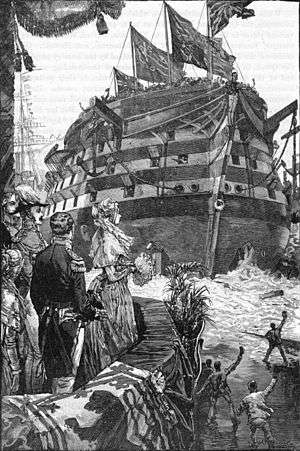Caledonia-class ship of the line
The Caledonia-class ships of the line were a class of nine 120-gun first rates, designed for the Royal Navy by Sir William Rule. A tenth ship (Royal Frederick) was ordered on 29 October 1827 to the same design, but was launched in 1833 as Queen to a fresh design by Sir William Symonds.
 Launch of HMS Trafalgar | |
| Class overview | |
|---|---|
| Name: | Caledonia |
| Operators: |
|
| Succeeded by: | Nelson class |
| In service: | 25 June 1808 – 1918 |
| Planned: | 10 |
| Completed: | 9 |
| General characteristics | |
| Type: | Ship of the line |
| Length: |
|
| Beam: |
|
| Depth of hold: | 23 ft 2 in (7.06 m) |
| Propulsion: | Sails |
| Armament: |
|
| Notes: | Ships in class include: Caledonia, Britannia, Prince Regent, Royal George, Neptune, Royal William, Waterloo, St George, Trafalgar |
Armament
In the original configuration, the armament of the Caledonia class was consistent for the first three ships of the class. The exception was an increase in firepower on the poop deck from 2 to 6 18-pounder carronades.
Starting with the fourth ship, the armament of the class was significantly modified to adhere to the principle of a unified caliber of 32 pound. All guns on the middle and upper gun decks were replaced with the same number of 32-pounders. Except for two 24-pounders on the middle deck that were replaced by two 8 inch shell guns. Four of the 12-pounder guns on the quarterdeck were replaced with 32-pounder carronades. The remaining two were increased to 18-pounders, along with the two 12-pounders on the forecastle, and the carronades on the poop deck were removed.
By 1847 the armament had been brought to the 32 pounder standard.
Size
The last five ships of the class were built to a slightly broadened version of the draught, and this sub-class was armed in the same way as the last of the standard Caledonias, HMS Royal George. Except for Caledonia herself, all these ships were converted into steam-powered screw battleships during the 1850s.
Ships
Standard group
- Builder: Plymouth Dockyard
- Ordered: 19 January 1797
- Laid down: 1 January 1805
- Launched: 25 June 1808
- Fate: Broken up, 1875
- Builder: Plymouth Dockyard
- Ordered: 11 June 1812
- Laid down: December 1813
- Launched: 20 October 1820
- Fate: Broken up, 1869
- Builder: Chatham Dockyard
- Ordered: 6 January 1812
- Laid down: 17 July 1815
- Launched: 12 April 1823
- Fate: Broken up, 1873
- Builder: Chatham Dockyard
- Ordered: 2 June 1819
- Laid down: June 1823
- Launched: 22 September 1827
- Fate: Sold out of the service, 1875
Broadened group
- Builder: Portsmouth Dockyard
- Ordered: 12 February 1823
- Laid down: January 1827
- Launched: 22 September 1832
- Fate: Sold out of the service, 1875
- Builder: Pembroke Dockyard
- Ordered: 30 December 1823
- Laid down: October 1825
- Launched: 2 April 1833
- Fate: Burnt, 1899
- Builder: Chatham Dockyard
- Ordered: 9 September 1823
- Laid down: March 1827
- Launched: 10 June 1833
- Fate: Burnt, 1918
- Builder: Plymouth Dockyard
- Ordered: 2 June 1819
- Laid down: May 1827
- Launched: 27 August 1840
- Fate: Sold out of the service, 1883
- Builder: Woolwich Dockyard
- Ordered: 22 February 1825
- Laid down: November 1829
- Launched: 21 June 1841
- Fate: Sold out of the service, 1906
References
- Lavery, Brian (2003) The Ship of the Line – Volume 1: The development of the battlefleet 1650–1850. Conway Maritime Press. ISBN 0-85177-252-8.
- Lyon, David and Winfield, Rif (2004) The Sail and Steam Navy List: All the Ships of the Royal Navy 1815–1889. Chatham Publishing, London. ISBN 1-86176-032-9.